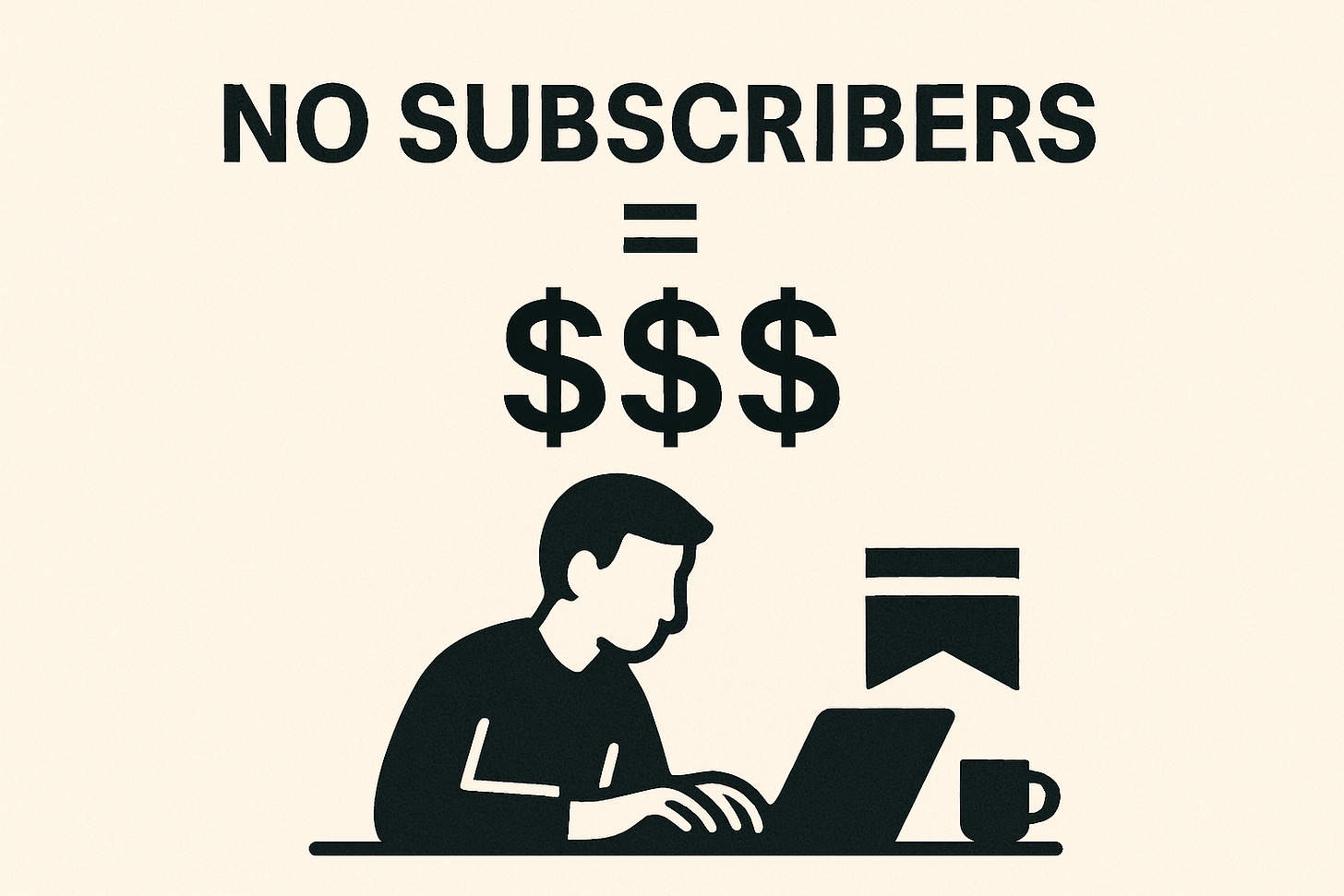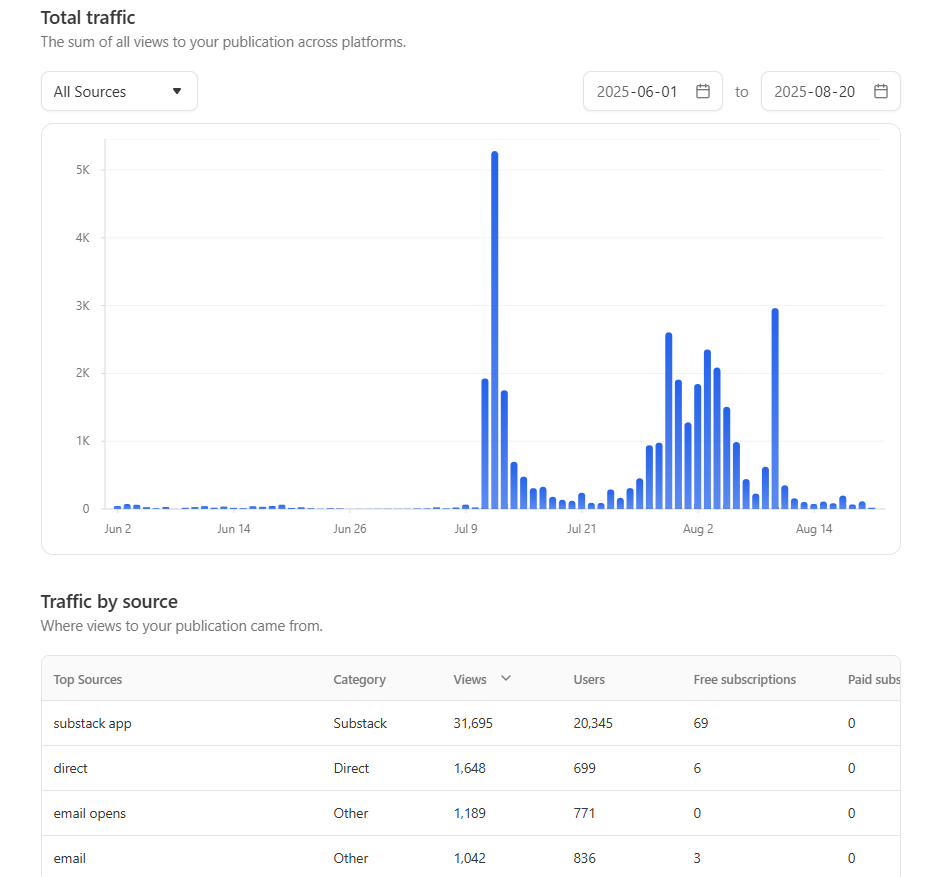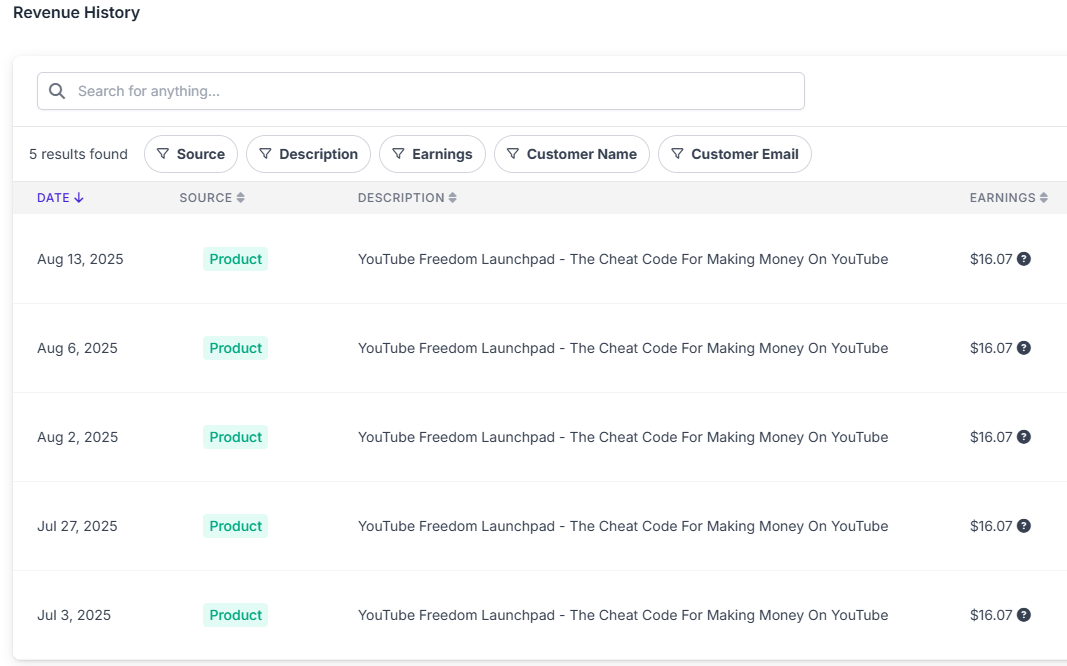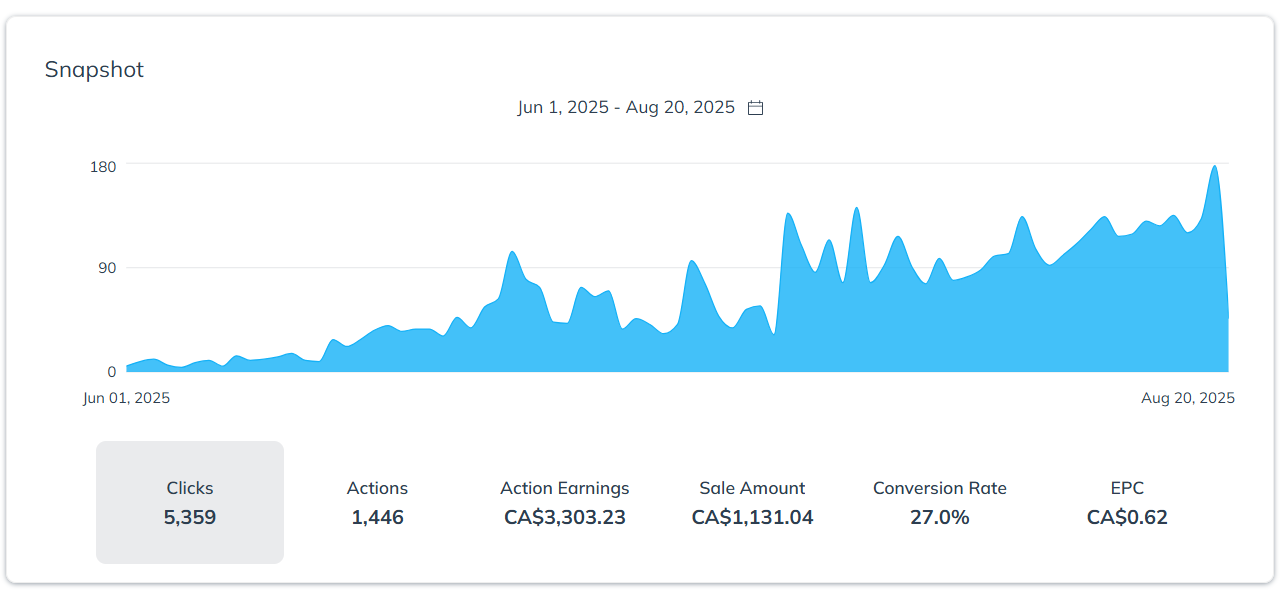Making Money On Substack In 60 Days With ZERO Paid Subscribers
No paywalls. No begging. Just smart strategies anyone can copy.
Most people think Substack works like this: You start a newsletter. You beg people to become paid subscribers. Someday, you magically make a living off of your words.
That’s the dream.
But it’s not reality for most people.
Getting people to whip out their wallets is hard. Keeping them around and preventing churn is even harder.
For most writers, using Substack as a content and value delivery engine is the most scalable path to making money with writing.
And so today, I’m breaking down how I made money in my first 60 days on Substack without a single paid subscriber.
I don’t have a Substack course to sell you. And if you don’t want to read about Substack monetization on Substack, fair play, I won’t cover this topic often.
But if you’re creating content and want to turn eyeballs into income, here are some of the strategies that have been working for me so far…No tricks, no begging, no “please buy me a coffee.” Just simple strategies that work if you create valuable content.
1. Start Using Affiliate Links!!!
One of the fastest ways I’ve made money with Substack is by using affiliate links for the products and services I recommend.
A lot of this stems from Substack being an amazing source of organic traffic right now.
I wrote my first Substack post on June 2nd, 2025. I didn’t really put much effort until July. In just over a month, Substack delivered over 35,000 views to my content:
I don’t think any other written-content publishing platform has this organic potential right now. So if you’re writing long-form content that helps people solve problems, making money with affiliate offers is a no-brainer.
I do this in a few ways, like:
Mentioning products and services I use in my content
Creating a Best Tools Page I promote
Plugging affiliates at the top of my newsletter, effectively sponsoring my own newsletter
Here’s a prime example: I wrote a post on how I used Lovable to vibe code a new income stream.
I actually use Lovable, so I plugged affiliate links in the article. Since then, it’s earned almost $40 from 3 conversions:
This isn’t life-changing money. But this is one post and one simple example.
If you write solution-focused content on Substack, my advice is to look for affiliate programs for the products and services you recommend.
Personally, my favorite affiliate networks (where you can find offers) for Substack writing are PartnerStack and Impact Radius. But you can do some Googling and you’ll probably find out many brands you use have direct affiliate programs these days.
ALSO 💵 It’s worth noting that you can find recurring-revenue affiliate deals. Lovable is one of these. So, while you’re ‘missing out’ on recurring revenue from paid Substack subscribers, you can make this up with recurring revenue for some affiliate programs.
2. Double-Down On What’s Working
The first post that popped off for me was my post on how to become wealthy with a one-person business.
Whenever you have something take off, do more of it.
It’s taken me so long to learn this lesson. But it holds true on YouTube, Substack, email newsletters, and basically any kind of business…Especially ones where algorithm push your content.
Since then, I’ve followed up this article with:
These posts have all done fairly well for my standards. If your audience tells you they like something, listen to them!
3. Offer Simple Upsells & Value Your Time
Once again, if you’re creating content that solves problems for your audience, there’s probably a percentage of your audience that’s willing to pay for extra help.
This can look like:
One-on-one coaching
eBooks
Courses
Offering one-time audits
Selling printables or other digital downloads
I’m relatively new to this on Substack. However, I’m happy with the early results: a few eBooks sales of my YouTube Freedom Launchpad eBook and one booking for a one-on-one content audit session.
This is about $230 in extra revenue between the eBook and consulting call, but I’ll take it. Selling digital products is awesome, and I’m excited to break more into coaching or consulting calls.
Building this funnel didn’t require gating content either. I publish content like my $250,000 YouTube framework and also make it easy for people to find my Pillar.io page where they can book a coaching/consulting call with me.
PS: If you want to go over your organic content strategy, funnels, and potential missed-revenue opportunities, I’d love to chat! 😊👉 https://pillar.io/tomblakefinance
4. Repurposing Substack Content Is A Massive Opportunity
Repurposing Substack content is something guys like Dan Koe do extremely well.
And really, with AI tools, repurposing your best Substack work into other content pieces is how you get more mileage out of the work you’re already doing.
I’m experimenting by creating a new YouTube channel where I essentially use my Substack articles as scripts for new videos.
This channel is just getting off of the ground. But producing videos here is way faster than scripting from scratch. All I need to do is hit record and then throw my raw video footage into Gling AI and it spits out ready-to-publish content.
Here’s a video I made after writing a post about how to stop living like an NPC:
Eventually, this channel will be monetized with YouTube Adsense. I’ll also sell digital products or affiliate offers through the description box. And if it actually grows, sponsors could be on the table too.
YouTube is where I suggest Substack writers begin repurposing. I think YouTube also has amazing organic reach, and there’s (hopefully) a couple years left for small creators to make it on the platform.
You can also repurpose your articles by:
Converting them into blog posts
Republishing them on platforms like Medium (just set the canonical tag correctly)
Turning your article into Tweets, notes, LinkedIn posts, or short-form social media bits
Covering the same idea on a podcast
If you offer a high-ticket service, I think repurposing is even more valuable. You can push every piece of high-value content further, and even getting a couple hundred extra views could mean closing a lucrative client.
5. Own Up To Monetization
One thing I learned a long time ago in my process of making $1 million blogging is that you just have to own up to monetization.
When you monetize content, there’s an inevitable loss of user experience. This is especially true if you’re on platforms that enable display ads, pop-ups, or other in-your-face tactics.
Substack is pretty clean from a UI perspective. But still, people know when you’re selling to them. Some of them will get angry with you, or call you a scammer, or write mean and nasty things in the comments!
Ultimately, if you want to make money with your content, you need to promote yourself and play the game to some extent. I believe it’s better being honest about it rather than trying to hide affiliate links or to downplay what you’re offering. If you’re creating something of value, don’t be afraid to promote it!
6. Email List Diversity Is Worth Thinking About
This Substack monetization tip won’t apply to everyone depending on your niche or what you’re selling…But I want to mention it.
I read this great article by
about how you might not own your Substack email list anymore.The gist of it is that platforms are increasingly making it harder to export your subscribers. After all, it makes financial sense for them to lock you in as soon as possible so the cost of switching platforms is too painful.
Owning an email list is critical these days so your business doesn’t depend on algorithms…But if a platform takes away your control, you’re in a similar boat.
Personally, this is why I use Substack for my higher-value content and then ConvertKit for some of my heavy affiliate content or lower-ticket stuff.
With Substack, I’m building an audience that cares about digital marketing, starting businesses, entrepreneurship, and topics I really love. And it’s been a ton of fun so far.
But when I eventually funnel people to some of my content sites or main YouTube channel, which covers a broader range of online opportunities, I push people to ConvertKit,
This is honestly because I use ConvertKit to send out way more content that’s less valuable than my Substack content. But it’s monetized very well with affiliate links and other offers.

I’m still warming up my sending domain on ConvertKit, so the deliverability is meh. But if Substack ever gets weird or I want to pivot, I’ll have this sending domain and won’t be caught without any options.
Anyways, the takeaway here is that if you’re funneling some of your audience to other platforms, thinking about building a separate list might make sense.
Substack doesn’t have to be your only email platform. I like using it for this specific niche and for higher-value stuff, while sending out 20x the volume of emails with ConvertKit that make money every day.
I’ve been ramping up an old affiliate account again, and this one is now hitting $50 to $100 per day, with a lot of this traffic being driven from ConvertKit sends. And this is peanuts compared to what many affiliate marketers make with their email lists.
You can try ConvertKit free for 14 days to get started!
Extra Reading 👉 How To Start Affiliate Marketing On Substack.
7. People Are Right About Substack Notes…
Just a quick lesson I learned: people are right about consistent note posting on Substack being a key to growing.
I don’t have any unique insights here.
Just try to post once in the morning and one or two more times throughout the day if you have something worthwhile saying.
Lately I haven’t had many inspiring thoughts. So I’ve been cheating by posting nice nature photos I take as a digital nomad 😂
8. Don’t Bother With The Fake ‘Like-For-Like’ Engagement Threads
One final thought about making money and growing on Substack.
I see some popular creators posting those “Hey everyone! I love you all so much! Let’s all drop our latest posts in this thread and engage with one another so we all grow together! 😍🙊🙉🙈” kind of posts on Substack. Yeah…Kumbaya.
This is one of the oldest, dirtiest tricks in the social media world.
It NEVER benefits anyone as much as the person posting the note/engagement thread. And in my experience, you basically never get any followers or traction by engaging with them.
In my experience, reaching out to people one-on-one to recommend each other’s Substack is a better approach.
A couple people have done this to me, so I actually haven’t done much outreach myself, but you end up with a mutually-beneficial arrangement this way that doesn’t require constant posting.
Final Thoughts
I hope this breakdown of my Substack revenue as a new creator has been helpful.
I’m very new to Substack. There are tons of people making way more money than me here, including many who rely on paid subscriptions.
But there are multiple ways to skin a cat, as they say. And that’s what I wanted to highlight in this post.
Also, if you’re against monetizing your Substack with these tactics, that’s totally fine too. Some writers don’t even monetize at all because this is a passion project or hobby. Also totally okay!
However, if you write online to try and make a living, I think these strategies will help.
I am convinced that the free, organic traffic we’re seeing now on Substack and certain platforms like YouTube won’t last forever. Maybe new platforms will pop-up where the gold rush begins again, but this kind of free attention rarely lasts long. So, I hope you can have fun, build an audience, create value, and monetize accordingly while the sun is shining!
And once again, if you want to chat about your organic content strategy or anything at all, you can always book a call and we can chat 😊👉 https://pillar.io/tomblakefinance
Thanks for reading as always.
I’ll catch you in the next one.
Tom from WiFi Wealth.
Note: Some of the links in this article are affiliate links. I may receive compensation when you sign up or make a purchase through these links at no additional cost to you. Thank you for supporting my work and writing.







we need to nurture our audience before closing them.